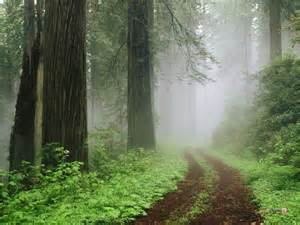As Emily Burns, of the Save the Redwoods League, explained last month during a volunteer enrichment talk, California’s redwoods store a great deal of carbon, but are highly influenced by climate and moisture. They also provide a living historical record of temperature, as Burns dramatically illustrated. Specimens of redwood trunk reveal almost no growth in 1580, which proved a mystery to ecologists. Until they searched the surviving written records of explorers from that time, who mentioned weather so cold that snow lasted nearly into summer and crew members dreaded getting out of bed.
Ecologists and meteorologists say that temperatures in the North Coast have stayed roughly the same, while the Bay Area and Santa Cruz have seen warming. Also, the region has experienced fewer cold days, rather than more hot days, and the frequency of foggy days has declined. Less fog isn’t good for the swordfern, which depends on the moisture, but may actually be a positive for redwoods, who need sun. Students and teachers at Chabot are tracking changes in swordfern frond size through the Communicating Climate Change initiative, as the plant gives a fairly accurate record of the amount of moisture at any particular time. Much of the predictive modeling surrounding climate change has focused on how redwood ecosystems withstand greater heat, so adjustments to the models are likely necessary to fully understand the effects of change.
Redwood forests reached their peak millions of years ago, and before European settlement of California, they covered 2.2 million acres of land. Now, there are 1.63 million acres of redwoods, 93 percent of which have been harvested and replanted. 23 percent of these live within parks or other protected land, and some of the protected trees date as far back as 328 and 474 A.D.
Changing forests bring about varied effects on the diverse animals and plants within the habitat. Owls are returning to newly replanted areas for better foraging, but still need old growth areas to hatch their eggs. The spotted owl now faces competition from the eastern bard owl, due to cross-country migration. The Steller’s Jay, which eats the less abundant marble merlet’s eggs, has now multiplied after eating food crumbs picnickers and hikers leave behind. Also, to the consternation of ecologists, black bears are now eating the sugary redwood bark.
Forty percent of wood growth by volume occurs in a redwood tree’s branches, and an older tree continues to expand there even when its rings become smaller with age. Researchers have found that redwood growth actually accelerates as trees get older. One ancient tree known as the Big Emerald puts on 1.6 cubic meters a year, enough wood to produce 2.3 million pencils. Conservationists seek to preserve trees of all ages, as young forests let in light for new growth, while older, deeply rooted trees better protect streams from erosion.
There is some reason for optimism about the future of the redwoods, as recent centuries have seen huge annual growth in the mass of California redwood trunks. With awareness and intelligent management, we can continue to preserve and enjoy this natural area for many more generations.
Cristina Deptula is a staff writer and may be reached at cedeptula@sbcglobal.net – and she welcomes paying freelance and professional writing positions.


Killer piece!